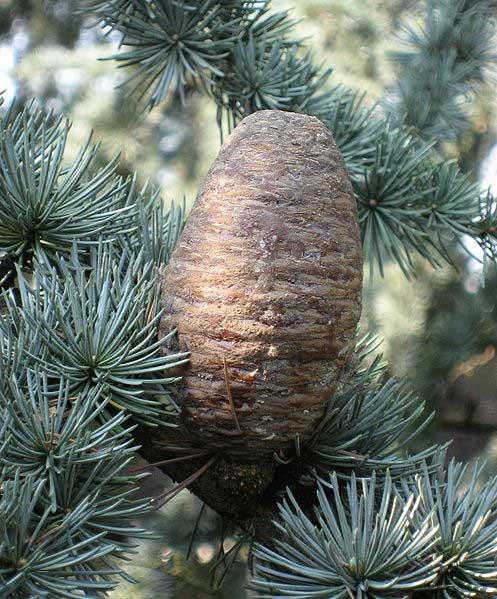Cedrus atlantica (*) Cladus: Eukaryota Name Cedrus atlantica (Endl.) Manetti ex Carrière Synonyms * Cedrus libani var. atlantica (Endl.) Hook.f.
* Hooker, J. D. (1862). On the Cedars of Lebanon, Taurus, Algeria and India. Nat. Hist. Rev. 2: 11–18.
Cedrus atlantica, the Atlas Cedar, is a cedar native to the Atlas Mountains of Algeria (Tell Atlas) and Morocco (in the Rif and Middle Atlas, and locally in the High Atlas).[1] A majority of the modern sources[2][3][4][5][6][7][8][9] treat it as a distinct species Cedrus atlantica, but some sources[10][11] consider it a subspecies of Lebanon Cedar (C. libani subsp. atlantica).
Cedrus atlantica is a medium-sized to large tree, 30–35 m (rarely 40m) tall, with a trunk diameter of 1.5–2 m.It is very similar in all characters to the other varieties of Lebanon Cedar; differences are hard to discern. The mean cone size tends to be somewhat smaller (although recorded to 12 cm,[1] only rarely over 9 cm long, compared to up to 10 cm in C. brevifolia, and 12 cm in C. libani, though with considerable overlap (all can be as short as 6 cm). The Cedrus atlantica leaf length (10–25 mm) is similar that of C. libani subsp. stenocoma, on average longer than C. brevifolia and shorter than C. libani subsp. libani, but again with considerable overlap.[1][12][7] Ecology Atlas Cedar forms forests on mountain sides at 1,370 to 2,200 m, often in pure forests, or mixed with Algerian Fir - Abies numidica, Juniperus oxycedrus, Holm oak - Quercus ilex, and Acer opalus. These forests can provide habitat for the endangered Barbary Macaque, Macaca sylvanus, a primate that had a prehistorically much wider distribution in northern Morocco and Algeria.[13] Cultivation and uses Landscape Cedrus atlantica is common in cultivation as an ornamental tree in temperate climates. In garden settings, often the glaucous forms are planted as ornamental trees, distinguished as the Glauca Group, a Cultivar Group. There are also fastigiate, pendulous, and golden-leaf forms in cultivation. The Atlas Cedar is useful in cultivation because it is more tolerant of dry and hot conditions than most conifers. It is used as a street tree, such as Christmas Tree Lane in Altadena, California. Many (but far from all) of the cultivated trees have glaucous (bluish) foliage, more downy shoots, and can have more leaves in each whorl; young trees in cultivation often have more ascending branches than many cultivated Cedrus atlantica.[14] An Atlas Cedar is planted at the White House South Lawn in Washington, DC. President Carter ordered a tree house built within the Cedar for his daughter Amy. The wooden structure was designed by the President himself, and is self supporting so as not to cause damage to the tree.[15] Forestry Cedar plantations, mainly with Cedrus atlantica, have been established in southern France for timber production. Cultural references George Harrison references the species in his song "Beware of Darkness." References 1. ^ a b c Gaussen, H. (1964). Genre Cedrus. Les Formes Actuelles. Trav. Lab. For. Toulouse T2 V1 11: 295-320 Source: Wikispecies: All text is available under the terms of the GNU Free Documentation License |
|

